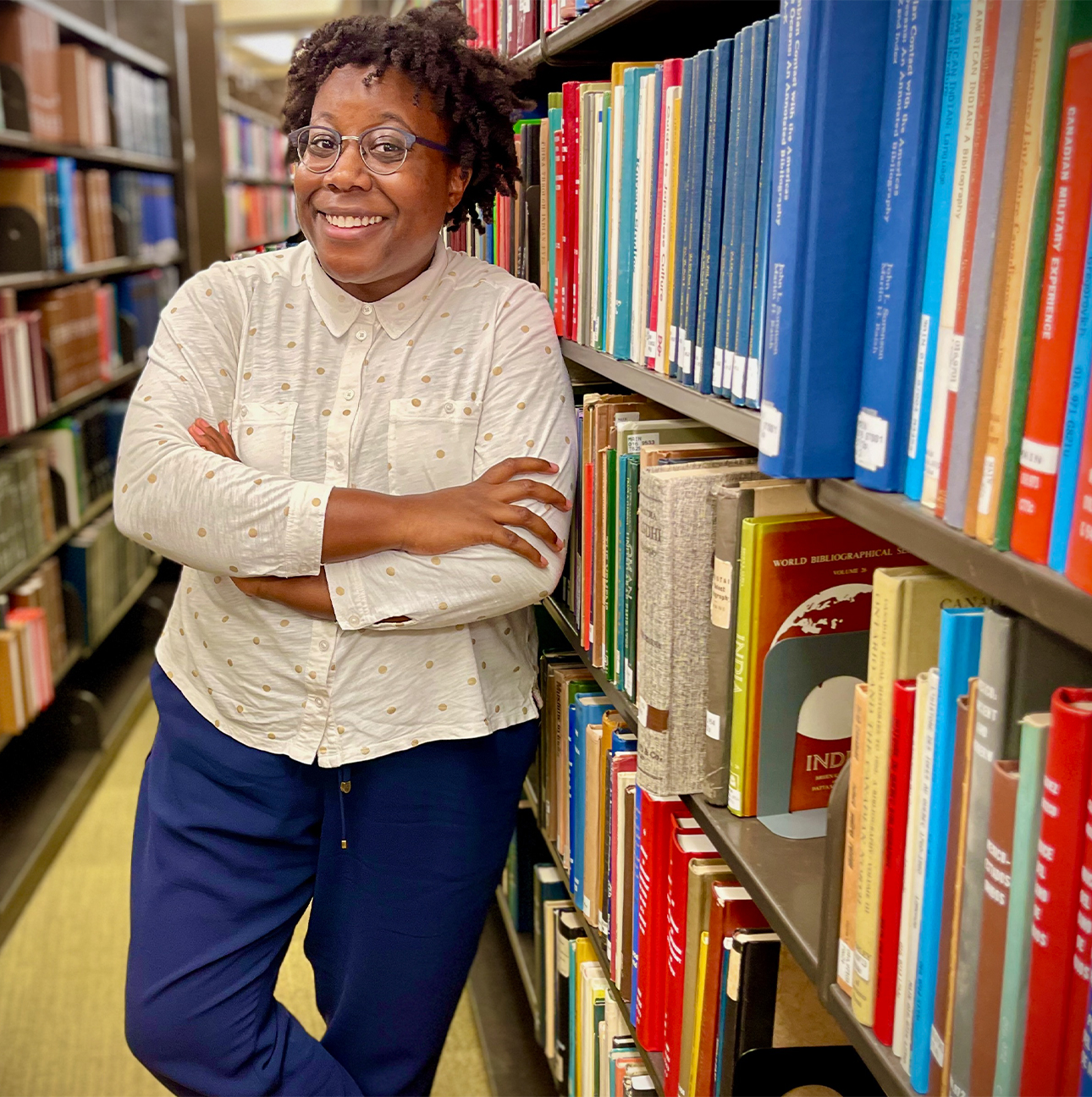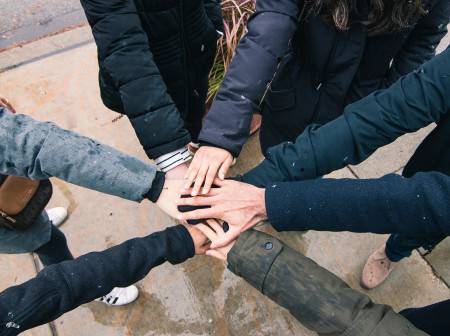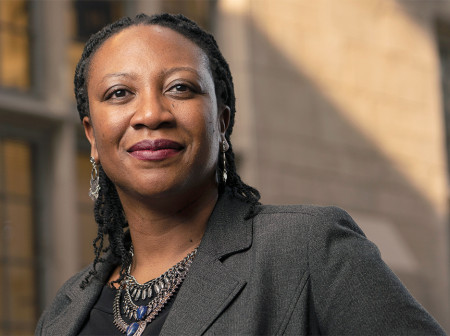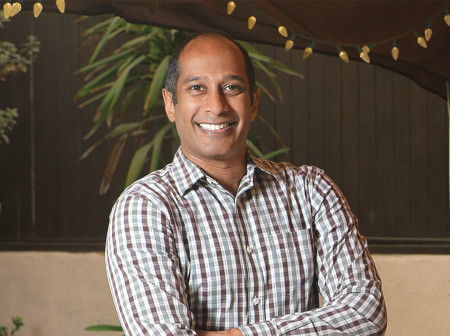Earlier this year Merriam-Webster added “misogynoir” to its English dictionary. Coined by Northwestern associate professor Moya Bailey, the word gives name to the specific type of prejudice that Black women experience in today’s society.
Bailey teaches courses on feminism, queer theory and social media in the Department of Communication Studies at Northwestern. She is the author of Misogynoir Transformed: Black Women’s Digital Resistance and a co-author of #HashtagActivism: Networks of Race and Gender Justice. She is also director and founder of the Digital Apothecary lab, housed at Northwestern, which examines the human and environmental impact of digital media platforms.
Bailey sat down with Northwestern Magazine’s Diana Babineau to discuss the origin of the word misogynoir, how the phenomenon persists today and the Digital Apothecary lab’s latest research endeavors.
Can you describe the origin of the word misogynoir?
In 2008, while I was writing my dissertation at Emory University, I wanted to talk about the way Black women were represented in these dated medical school yearbooks I was studying. Unfortunately, those negative representations from as far back as the 1910s matched what I was seeing in modern media. And I thought, ‘What was it about this representation of Black women that had remained unchanged for nearly 100 years?’
That is how I started to think about the term misogynoir: the anti-Black, racist misogyny that Black women — and people perceived as Black women — experience. It is a portmanteau of misogyny and noir — referring both to the French word for the color black as well as the film genre noir, because one of the ways that I see misogynoir showing up is often in media.
I first used the word publicly in a 2010 post on the Crunk Feminist Collective blog when I was talking about listening to contemporary hip-hop and not feeling particularly moved one way or the other about the misogynoir I heard in the music. I was a bit shocked at my own lack of reaction, of being nonplussed about it, and it gave me pause … to think about how ubiquitous misogynoir is — it’s everywhere, to the point where I’m not even affected by its presence.
Can you give an example of how misogynoir manifests today?
Just recently we saw the death of Olympic gold medalist Tori Bowie, who died due to childbirth complications. She was on of a team of four Olympian Black women, three of whom have had complications related to their pregnancies, and Black women have the worst maternal mortality rates in the U.S. To me, that’s an example of misogynoir — there are these disproportionate negative health outcomes for Black women, even athletes who are in peak physical health. There’s no other explanation except for the particular combination of anti-Black racism and misogyny that’s impacting their birthing experiences.
Why is it important to put a name to the way that Black women are mistreated in society?
When you’re able to describe exactly what people are experiencing, it makes it that much easier to address it. It’s hard to address something that you don’t have context for. Giving the experience of misogynoir a name gives us a place to build and organize from. I’ve seen so many people find the language helpful in their own activism.
What was it like to hear that misogynoir was added to Merriam-Webster?
When I got the email from Merriam-Webster that the word that I created was being added to the dictionary, it was really a bit of a shock. It is still something I can’t fully put my mind around, especially since it’s not a particularly pleasant word.
It’s been exciting, but it feels like a double-edged sword because the fact that it needs to be added to the dictionary reflects just how common, how far-spread misogynoir is in the world, and that’s pretty disheartening. I’m actually looking forward to the day when the word gets retired.
What is the Digital Apothecary lab?
The Digital Apothecary lab is the space that my students and I have affectionately called “a lab for the lab-less.” It’s a space for humanities and social science researchers to think about some of the big digital questions of our time while also critiquing the ways that digital platforms have impacted our world. How do we create digital material that helps us get closer to the world we want? Are there different strategies that we can use to lessen the environmental impact of digital platforms? These are some of the big questions that our lab is grappling with.
How can a digital space impact our physical environment?
When we look at the internet, we imagine it as something ethereal, something living in the cloud. But the cloud is actually a physical place, and we need to think about its environmental impact on our world.
I wrote a book with some co-authors called #HashtagActivism, and in the process of writing that book we looked at the social justice activism that took place on Twitter (recently renamed X), through activists’ hashtags. It’s great that people have been able to use social media to create all this material, but some of the servers that hold our data “in the cloud” are being cooled using potable water from small, rural communities. That becomes water that communities can no longer use.
If we go back further, we can think about children in the Democratic Republic of Congo who are mining the precious minerals needed to create the Apple products people use.
All of these different people are impacted by our use of digital technology, but we don’t often think about the human impact of the internet.
What is your lab working on now?
One of the goals of the Digital Apothecary lab is to fight against misogynoir in digital spaces. And one of the ways we do that is by looking at how different platforms deal with issues of accessibility or racism.
One student in my lab, Jamie Cooley, is looking at how TikTok decides — or rather, how TikTok users decide — what videos go viral. Cooley, a doctoral student in Northwestern’s Media, Technology and Society program, is investigating whether there’s a pattern in the kinds of representation that we see in those videos. Are captioned videos more accessible or more viral than others? Are videos that have hate speech perhaps more viral than others? I’m really curious to see how this research might impact the design of these platforms, to better address misogynoir and other societal issues as they come up in these digital spaces.
This interview has been edited and condensed for clarity.




Reader Responses
No one has commented on this page yet.
Submit a Response